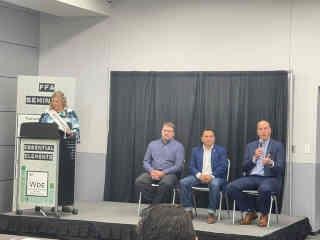AEM staff and association member company leaders continue to do their part in telling the story of the dairy industry, shedding light on the value of modern dairy technologies and illustrating how they have positively impacted consumers, dairy farmers and cows over the past 15 years.
In addition to working with The National Milk Producers Federation and Dairy Farmers of America to issue the Environmental Benefits of Modern Dairy, Hay, and Forage Production Technologies study, AEM also hosted a pair of events at last week’s World Dairy Expo in Madison, Wisconsin to unveil the study and engage the public, highlight advancements in dairy and encourage adoption of new technologies.
“We must work together to build consumer trust not only in our practices, but the equipment we used and the impact that those things have on both the environment and the animal,” said AEM Director of Agricultural Services Austin Gellings, who presented the study to the public at World Dairy Expo. “Our industry has a great story to tell. And moving forward we have the opportunity to provide solutions to a number of the challenges our society faces, but we have to work together to get that message out.”
AEM unveiled its study during a Knowledge Nook presentation held at World Dairy Expo, where Gellings presented to a crowd of event attendees comprised of farmers, equipment manufacturers, trade media professionals and others. Following the presentation of the study, folks were invited to attend a press conference and Q&A session featuring AEM member company representatives Matt Daley, president of GEA, Chad Huyser, president of Lely North America, and Fabian Bernal, global head of sustainability at DeLaval, along with moderator Taylor Schaefer, the 75th Alice in Dairyland.
Check some photos from this year’s World Dairy Expo below:

Click here to see more...